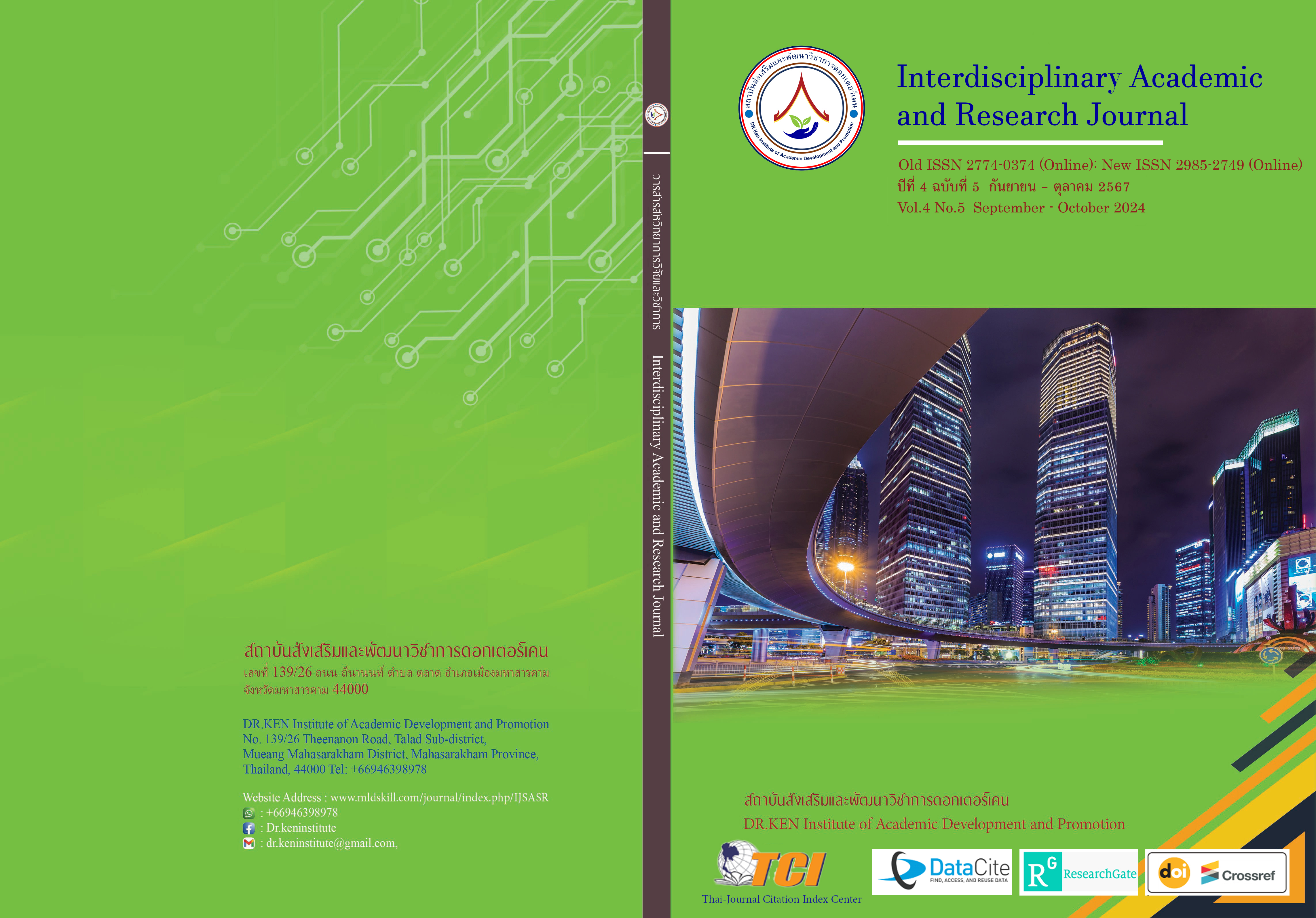Enforcement of the Skill Development Promotion Act B.E. 2545 of Business Establishments in Samut Prakan Province
DOI:
https://doi.org/10.60027/iarj.2024.276177Keywords:
Work performance,, Development, , LaborAbstract
Background and Aims: These include the modifications to the global economic landscape brought about by the Industry 4.0 trend—the move toward new technologies and creative business practices. In the contemporary economic world, labor will be the primary mechanism for change. The objectives of this research were; (1) to study the level of work performance under the Skill Development Promotion Act, B.E. 2545, of the business establishments, (2) to study the level of enforcement results under the Skill Development Promotion Act, B.E. 2545 of business establishments, (3) to study the relationships between work performance and the enforcement results under the Skill Development Promotion Act, B.E. 2545 of business establishments, and 4) to study the recommendations for the success of work performance under the Skill Development Promotion Act, B.E. 2545 of business establishments.
Methodology: The province of Samut Prakan hosted this study. The research instrument used in the study was a 50-item, open-ended, five-closed rating scale questionnaire with a reliability coefficient of 0.98. The samples were 309 representatives of business establishments in the enforcement area under the Skill Development Promotion Act B.E. 2545 in the year B.E. 2565 in Samut Prakan Province, as determined by Yamane's formula and chosen through a systematic random sampling technique. At a statistical significance level of 0.01, the statistics included frequency, percentage, mean, standard deviation, and linear multiple regression analysis using the Stepwise method.
Results: The study's findings demonstrated that: (1) The overall work performance of Samut Prakan Province's business establishments was rated at a moderate level under the Skill Development Promotion Act, B.E. 2545. (2) The relationships between work performance and the enforcement results under the Skill Development Promotion Act, B.E. 2545 of business establishments in Samut Prakan Province were rated at a high level. The level of enforcement results under the Act was obtained from business establishments in Samut Prakan Province collectively. (3) Overall, Samut Prakan Province business establishments' work performance and the enforcement results under the Skill Development Promotion Act, B.E. 2545, were found to be moderately correlated, with a statistically significant correlation at the.01 level and a multiple correlation coefficient of.673 (R=.673). With an R2 value of.454 and an F value of 84.396, all independent variables can explain variation in the variables equal to 45.4 percent. This is statistically significant at the.01 level and suggests that the independent variable is related to the outcomes of enforcing the Skill Development Promotion Act, B.E. 2545, of business establishments in the Province of Samut Prakan. There are three variables in the equation: the state of not being subject to the enforcement of labor relations and labor protection laws; and the receipt of advice, guidance, and assistance in various cases from the Department of Skill Development. (only when training is being done to get ready for the workforce) and the ability to have income tax exemptions for labor skill training costs in certain circumstances. (4) The following recommendations are made for how the Skill Development Promotion Act, B.E. 2545, should be applied to businesses in the province of Samut Prakan: A training program should be implemented to increase awareness of the rights of foreign entrepreneurs to hire skilled workers continuously. It is advisable to prepare handbooks outlining the advantages and rights of hiring foreign workers as artisans. A training program ought to exist to impart knowledge and comprehension of the training requirements necessary to apply for income tax exemption rights.
Conclusion: The study concludes that although work performance in Samut Prakan's businesses is moderate, the implementation of the Skill Development Promotion Act, B.E. 2545, has had a significant positive impact. Improving corporate results and Act compliance requires stronger enforcement and training initiatives.
References
กรมพัฒนาฝีมือแรงงาน (2566).แผนปฏิบัติ ราชการ ระยะ 5 ปี (พ.ศ.2566-2570). กรมพัฒนาฝีมือแรงงาน, กระทรวงแรงงาน.
กรมพัฒนาฝีมือแรงงาน, กระทรวงแรงงาน. (2564). เอกสารแนะนำกรมพัฒนาฝีมือแรงงาน. กรุงเทพมหานคร: ผู้แต่ง.
กรมพัฒนาฝีมือแรงงาน, กองส่งเสริมการพัฒนาฝีมือแรงงาน. (2560). คู่มือแนะนำการใช้พระราชบัญญัติส่งเสริมการพัฒนาฝีมือแรงงาน พ.ศ. 2545 สำหรับเจ้าหน้าที่. กรุงเทพมหานคร: ผู้แต่ง.
กระทรวงแรงงานประเทศไทย. (2545). พระราชบัญญัติส่งเสริมการพัฒนาฝีมือแรงงาน พ.ศ. พ.ศ. 2545 (2545). กรุงเทพฯ: กระทรวงแรงงาน.
ชาติเฉลิม สุรชัยชาญ. (2544). ปัจจัยที่มีผลต่อความต้องการพัฒนาขีดความสามารถในการทำงานของกำลังแรงงานไทย. วิทยานิพนธ์ปริญญามหาบัณฑิต: จุฬาลงกรณ์มหาวิทยาลัย.
ทิวา ดอนลาว, สมพร เฟืองจันทร์, เพ็ญศรี นิรินัง และวิวัฒน์ กรมดิษฐ์. (2565). อนาคตแรงงานไทยภายใต้ภาวะเศรษฐกิจที่เปลี่ยนแปลง. Journal of Administrative and Management Innovation, 9(1), 35-44.
ธัชวัฒน์ พากพูลไพร และชาติ วรรณกุล. (2557). ปัจจัยที่ส่งผลกระทบต่อการพัฒนาฝีมือแรงงานของสถานประกอบการจังหวัดกาฬสินธุ์. ในการประชุมนำเสนอผลงานวิจัยบัณฑิตศึกษา (น. 1898-1909). ขอนแก่น: มหาวิทยาลัยขอนแก่น.
นริศรา บุญเที่ยง. (2562). ความพร้อมในการฝึกอบรม กระบวนการฝึกอบรม และความพึงพอใจในการฝึกอบรมที่มีผลต่อแรงจูงใจในการนำการฝึกอบรมไปพัฒนาในการทำงานของพนักงานธนาคารพาณิชย์ในโซนถนนรัชดาภิเษก. วิทยานิพนธ์มหาบัณฑิต: มหาวิทยาลัยกรุงเทพ.
พัฒนา สุขประเสริฐ (2541). กลยุทธ์ในการฝึกอบรม. กรุงเทพฯ: มหาวิทยาลัยเกษตรศาสตร์.
ศิริพงษ์ ลดาวัลย์ ณ อยุธยา. (2551). เอกสารประกอบการสอนกระบวนวิชาการบริหารแรงงาน. เชียงใหม่ : คณะรัฐศาสตร์และรัฐประศาสนศาสตร์ มหาวิทยาลัยเชียงใหม่.
สำนักงานคณะกรรมการพัฒนาการเศรษฐกิจและสังคมแห่งชาติ สำนักนายกรัฐมนตรี. (2559).แผนพัฒนาเศรษฐกิจและสังคมแห่งชาติ ฉบับที่ 12 พ.ศ. 2560-2564. กรุงเทพฯ: สำนักงาน คณะกรรมการพัฒนาการเศรษฐกิจและสังคมแห่งชาติ.
เสกสรร จิตพงษ์. (2560). แนวทางการพัฒนาฝีมือแรงงานในจังหวัดยโสธร รองรับการเปิดประชาคมอาเซียน. วิทยานิพนธ์มหาบัณฑิต: มหาวิทยาลัยราชภัฎมหาสารคาม.
อัญชิษฐา ชาญณรงค์ (2560) . แนวทางการพัฒนาประสิทธิภาพการให้บริการประชาชนของสถาบันพัฒนาฝีมือแรงงาน 11 สุราษฎร์ธานี. วารสารสถาบันวิจัยญาณสังวร, 9(2) , 92-93.
Boonpattarakan, A. (2012). The role of the Skill Development Promotion Act in enhancing vocational education and training standards in Thailand. International Journal of Training and Development, 16(3), 212-230.
Pholphirul, P. (2014). Evaluating the enforcement and impact of the Skill Development Promotion Act in Thailand. Labour Market Research and Policy Journal, 19(4), 321-339.
Rungfamai, K. (2015). An analysis of the effectiveness of tax incentives under the Skill Development Promotion Act. Asian Economic Policy Review, 10(1), 85-102.
Tansakul, S. (2010). The impact of the Skill Development Promotion Act on workforce training in Thailand. Journal of Southeast Asian Economies, 27(2), 123-138.
Downloads
Published
How to Cite
Issue
Section
License
Copyright (c) 2024 Interdisciplinary Academic and Research Journal

This work is licensed under a Creative Commons Attribution-NonCommercial-NoDerivatives 4.0 International License.
Copyright on any article in the Interdisciplinary Academic and Research Journal is retained by the author(s) under the under the Creative Commons Attribution-NonCommercial-NoDerivatives 4.0 International License. Permission to use text, content, images, etc. of publication. Any user to read, download, copy, distribute, print, search, or link to the full texts of articles, crawl them for indexing, pass them as data to software, or use them for any other lawful purpose. But do not use it for commercial use or with the intent to benefit any business.
















.png)


